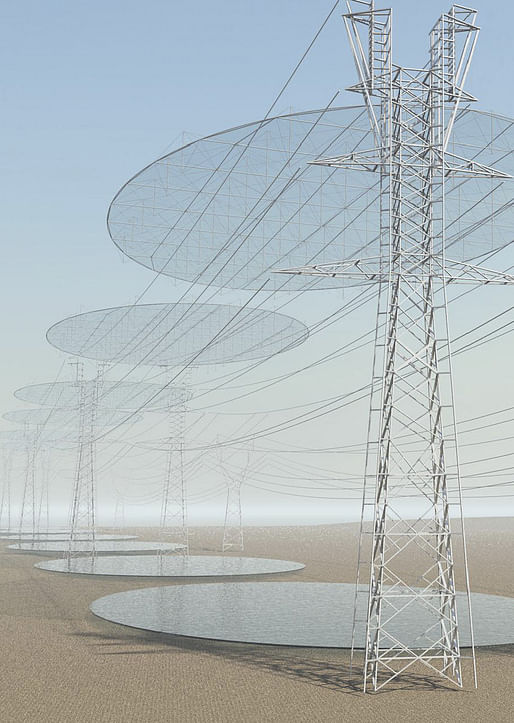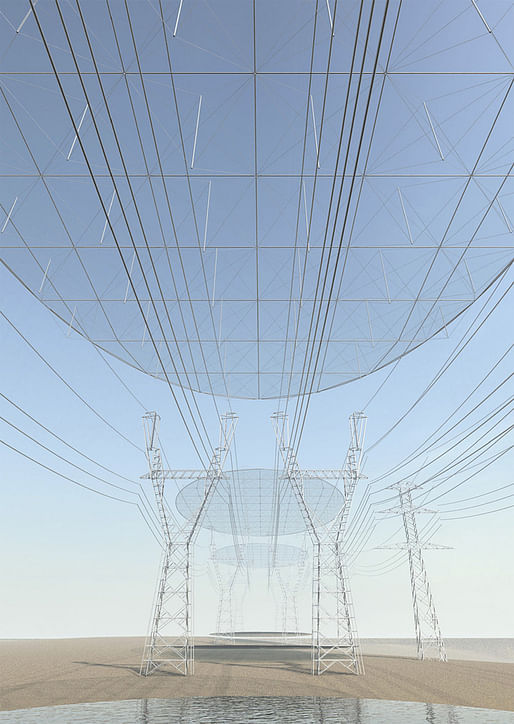

In the lead-up to the Beijing Olympics, there was a flurry of news about the Chinese government's attempt to seed clouds in order to engineer the weather. In fact, the technology – while largely considered imperfect – both exists and has been implemented. The SEEDING MICRO-CLOUDS. Power Transmission Lines & WaterTransmission Surfaces Honorable Mention proposal imagines a future in which existing infrastructure could be employed to serve as the base for a micro-cloud seeding operation to provide water to a thirsty California.
"SEEDING MICRO-CLOUDS. Power Transmission Lines & WaterTransmission Surfaces," by Cristina Jorge Camacho
INTRODUCTION. Why electric infrastructure is so important compared to water supply? How we can restore the natural balance? Cyberspace does not exist without electricity, humanity cannot survive without water. It is possible to take advantage of using electric grid for helping improve water resources. Transmission towers’ structure with an additional structural reinforcement could provide support to a new artificial clouds network made of light galvanized steel bars and strings, nebulizers system and silver iodide canyons. Under these clouds there are covered or open water reservoirs depending on topography, climate and soil conditions and they are connected from mountains to the city. These water banks create additional supply water system for local residents and transmission water surfaces connecting the whole micro water reservoirs. The initial amount of water required for nebulizers system from water reservoirs will be recovered and incremented by micro-clouds’s rain caused by silver iodide canyon which transform water vapor into snow.
METHOD. In the micro-clouds’ network are employed small dust seed chimneys located in the reinforcement of transmission tower creating reservoirs for local use as well as water pipelines to build infrastructure to store and transport water to where it is needed. There are five main project’s elements:
1 Micro-Cloud Structure. Tensegrity structures consist of strings (in tension) and bars (in compression). Strings are strong, light, and foldable, so these structures have the potential to be light but strong and deployable. Prestressing all strings of a tensegrity makes its shape robust to various loading forces. The shape of a tensegrity structure can be changed substantially with little change in the potential energy of the structure. The use of self-similar structures allow to find minimal mass subject to a specified buckling constraint. Light structure is calculated for wind and snow loads.
2 Nebulizers’ network. Nebulizers system is incorporated over tensegrite structure each 20cm and can operate automatically by using solenoid valves and specific hydraulic station. The high-pressure of nebulizers is carried out by high-grade steel jets with tiny apertures of 120 microns in diameter, through which the water is forced at a pressure of 80 bars onto fine needle points directly above the apertures and atomised into innumerable tiny droplets 4 to 10 microns in diameter, as Blur’s project. A set of distribution lines are made of a special aluminum alloy (pipes Ø 33 or 40) with a quick joint made out from pipe itself.
3 Reinforcement of transmission tower’s structure. The same galvanized steel profiles of the original transmission tower are used in the reinforcement with dry assembly and earth connection. Micro-clouds system is hanging from prestressed strings from one tower to another.
4 Silver iodide canyon. The chimney located in the reinforcement of tower structure releases tiny particles of silver iodide over the micro-clouds. The goal of iodide salt canyon is to disperse substances into the air that serve as cloud condensation or ice nuclei, which alter the microphysical processes within the cloud.
5 Water reservoirs & Shade balls. There is a water reservoir under each artificial micro-cloud which storages water for local use and transports it for water supply of the cities. The Great Lakes region is intimately connected to one of the largest fresh water systems on Earth, a full 20% of the world’s fresh surface water. Unfortunately, this great privilege is being threatened by the leading source of water pollution: incorrect management of rain and storm water.
6 Rain gardens & Water treatment. It is a shallow depression that is planted with deep-rooted native plants and grasses. Their characteristic are: reduces flooding and erosion, less imported water used for yard irrigation, lower water bills, less polluted storm water runoff and biodiversity recovery. It is an action against rain and snowmelt flowing off of yards, roofs, and sidewalks and washing pollution into water systems. Rain gardens are designed to collect and absorb runoff from a roof or parking lot, the way nature intends rain to soak into the soil. Even it is a way to stop evaporation over water reservoirs.

LOCATIONS. Micro-clouds’s network hanging from new strings belongs to the reinforcement of transmission power towers is an additional water infrastructure for linking water reservoirs which are located under these clouds. Tensegrity structure is connected with nebulizers units. Silver Iodide is injected into these artificial clouds by seeding canyons which are located on the top of the reinforcement of transmission tower structure. These networks are tested in three different areas in the state of California searching the main towers and transmission lines:
1 CA High Richardson & Roaring Creek (Mountains). Pacific Gas & Electric Co. Intervention is linked with the recovery of soil permeability. Aridity extends water research along vast distances, from the melting of the glaciers in the Rocky and Sierra Morena Mountains, which run along coastal line. Runoff is stored and separated from territory to transport water through kilometric tubes and pipes to hermetic reservoirs located in the city. Topography is ignored by energy efforts such as pumping stations which invert the decreasing field of potential energy. Water is relocated and disconnected from local topography because of pipelines’ network which provides water supply and sewage, treatment plants, purifiers and the point of effluent discharge in the Pacific. For those reasons, connecting micro-clouds’ reservoirs could be an alternative porous proposal to the tubes and pipes of existing water infrastructure. It could be new management of aquifers .The excessive extraction of subterranean water has left groundwater level below local vegetation’s roots generating great amount of salt which is the origin of dust formation. Salinization, aquifer depletion and progressive accumulation of sediments reveal the instability of hydraulic system. Water banks could be an instrument to manage droughts. Experience acquired in emergency drought water banks in California provides certain lessons for the future development of these banks. These micro-clouds act such as sprinklers grid that try to reduce dust dispersed into lakes for recovering biodiversity, at least bird’s settlements. At the same time, micro-clouds’ reservoirs try to increase the amount of water of subterranean aquifers.
2 CA Mid Madison (Agricultural lands). Desert Research Institute. The decentralization of engineered infrastructure must make way for practical reclamation of biophysical processes and reintegration of ecological flows, relating the macro to the micro-scale of biological studies. In the case of small biotopes, connected islands of landscape reveal the possibility of using balanced resources, which consist of the right qualities and proportions of water, drainage, minerals and electricity need to maintain growth. Biotopes networks and polycentric nodes of resources are generating live-work patterns that are increasingly distributed and dispersed. The original geometry will be affected by the impacts of extreme weather events and the time of day or night; moving away from the desire to impose static order such as rigid geometric design on nature which is rare, and usually temporary, passing through the micro to the macro scale of thermodynamic/climatic parameters,. Landscapes are dynamic and the result of physical processes (such as erosion and sedimentation) and biological processes (involving growth, blossoming and decay).
3 CA Low Diablo Canyon Nuclear Power Plant (Coast zones). Santa Barbara County. How can we use and protect the value of the landscape which surrounds a nuclear power station located close to the ocean or a river by several safety protection cycles?. Rivers and oceans are multi-faceted ecological, cultural, economic, and political agents, providing resources such as food, water, irrigation, sanitation, and transportation- and liabilities including flooding and drought. Both of them are cool water sources because of the steam must be cooled after it runs through a turbine to produce electricity and for that reason it is necessary to preserve water natural sources and ocean wildlife. At the same time the coastal area provide the possibility of topographical intervention by mounds of protection and foil storage, voids of salt stepper and desalinizations and islands of renewable energies. The multiple non-electric applications of nuclear energy and cogeneration allow to visualize new topographies which are small landform buildings with large areas of production: salt fields, water desalination plants, hydrogen generators, transport research centers (airdromes, ship propulsion, nuclear submarines, supply spacecraft energy), district heating, and natural reserve centers. Mounds as inclined platforms were the initial human response to flooding by artificial reefs which have long been used to reduce wave height and dissipate the waves energy. Voids are also used for coastal adaptation to make more room for floodwaters. Islands are artificial surfaces that are designed to move, pushed along by waves, growing vertically by sediment or floating like dynamic landforms.

CONCLUSIONS. Electric lines are much like water pipes. In the case of transmission lines, the higher the voltage, the more electricity that can be transmitted, just like a wider water pipe can carry a larger volume of water. Electrical transmission lines operate at high voltages and carry large amounts of electricity over long distances. New water networks would make use of the topography, permeability and existing infrastructure. These micro-clouds are also important to reduce fire risk, one of the consequences of droughts. Nature’s endorsement of tensegrity structures are efficient because per unit mass, spider fiber is the strongest natural fiber and these structures are transferrable form nano- to mega scale. This a great challenge to develop scientific procedures to create smart tensegrity structures that can regulate the flux of water resources, as well as, thermal, mechanical and electrical energy in a material system by proper choice of material, geometry and controls.
1 Future Water & Energy Resources CA High Richardson & Roaring Creek (Mountains)
2 Future Water & Energy Resources CA Mid Madison (Agricultural lands)
3 Future Water & Energy Resources CA Low Diablo Canyon Nuclear Power Plant (Coastal zones)
-
From the judges:
"Provocative if totally utopian" – Peter Zellner
Check out the image gallery for Growing Energy from Waste's complete presentation.
Click here to see the other winners in both the Pragmatic and Speculative categories!
No Comments
Block this user
Are you sure you want to block this user and hide all related comments throughout the site?
Archinect
This is your first comment on Archinect. Your comment will be visible once approved.